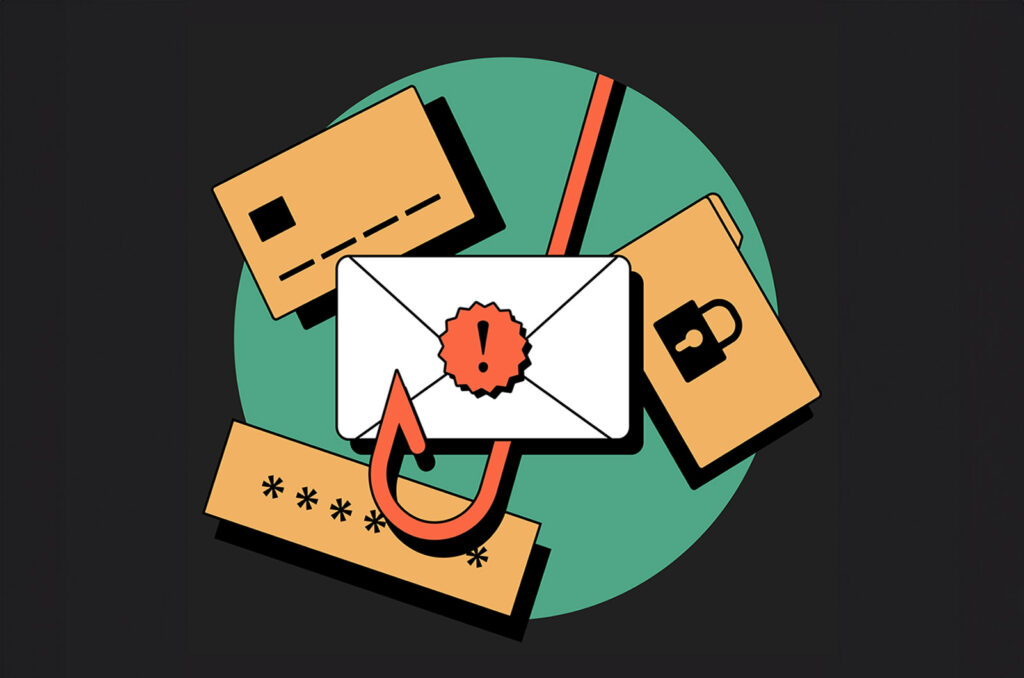You may have heard that data breaches are not a matter of ‘if’ but ‘when’. This may seem like an overly dramatic take until you take a look at cybersecurity statistics.
In 2023, half of businesses (50%) and a third of charities (32%) reported having experienced some form of cyber security breach or attack in the last year. For medium and large businesses, the number is even higher (70% and 74%). This means that data breaches may occur to everyone – regardless of whether you’re a small business owner or part of a large enterprise.
What are the most common types of data breaches? What practical steps can you take to keep your information safe? We discuss this and more in the article below.

The most popular types of data breaches
Phishing
Even if you’re unfamiliar with types of data breaches, chances are you’ve heard the term ‘phishing’. Similar to password attacks, which we’ll talk about later, phishing aims to obtain the login credentials of its victim.
To do this, the attackers often pretend to be legitimate service providers by copying real websites or directly contacting the victim through email or phone. Using their deceptive techniques, the attackers can trick individuals into revealing sensitive information.
Why is it so challenging to protect your business from a phishing attack? Because it only takes one employee to fall for the scam for a data breach to happen. To reduce the risks of such incidents occurring:
- Invest time in employee training and educate your staff on identifying suspicious messages
- Implement two-factor authentication (2FA) for all your systems
- Take advantage of advanced email filtering solutions
Ransomware
When you think of a typical data breach, ransomware is probably the first thing that comes to mind. That’s not surprising – in the US alone, there are seven ransomware attacks every hour.
Stemming from cryptovirology, these types of attacks are designed to deny organisations access to files on their computers. After encrypting these files, the criminals usually demand a ransom payment.
Of course, paying the requested money doesn’t guarantee that you’ll get your data back or that your sensitive information won’t become public.
To protect yourself from ransomware attacks, you should:
- Maintain up-to-date backups of all of your data.
- Consistently monitor your software vulnerabilities.
- Ensure all your devices and applications have cutting-edge security features (long gone are the days of installing a few apps and then leaving them).
Password attack
According to a study by NordPass, among the most commonly used passwords are ‘123456’, ‘qwerty’,’123456789′, ‘password’, and ‘111111’. If you’re currently using one of them, make sure to change it as soon as possible!
Password attacks, sometimes also called password bombing, make use of software that repeatedly tries different, popular combinations of passwords and email addresses.
Once the attackers find a password and email address that match, they usually try to use it on other websites as well.
So, what’s the solution?
- Encourage your employees to create strong, unique passwords for each account (if possible, take advantage of password managers, which will generate more complex passwords).
- Invest time and energy in keeping employees updated on the best security practices.
- Conduct regular security assessments to figure out potential vulnerabilities.
Stolen information (due to human error)
Shockingly, 95% of all data breaches occur due to human error. These mistakes can sometimes cost a business hundreds of thousands, if not millions, of pounds. Just take Apple as an example. In 2011, when a careless employee left a prototype of one of the new iPhones lying around, just a couple of hours later, the internet had all the new specs.
If something like this can happen in a massive corporation with some of the most skilled people on their team, it can certainly occur in other companies as well. To prevent this from happening, you should focus on creating a culture of awareness within your business. While it may not be possible to eliminate human error entirely, you can minimise it by:
- Ensuring your employees only have access to the data that they need to perform their roles
- Encouraging the creation of strong passwords and mandating the use of two-factor authentication
- Making it easy to ask questions (and rewarding those employees who bring up good questions)
Malicious insiders
Sometimes, data breaches occur due to unmalicious human error. But in some cases, your employees, contractors, business partners, and anyone else with access to your information can be a risk too.
Why, you ask? There can be many reasons, but most importantly, your data is a precious asset. By stealing some of your information, the attacker can gain profit.
Unfortunately, insider threats are quite challenging to detect and prevent since the attackers already have access to your data. However, there are ways you can reduce the risks:
- Use monitoring and auditing tools to detect suspicious activities as early as possible
- Create a well-defined response plan in case a breach does occur
- Follow the principle of least privilege
Final thoughts
In the current business world, the internet plays a massive role, so it should not come as a shock that there are many threats lurking around the web. While the statistics of data breaches paint a sobering picture, there are many steps you can take to protect your data and mitigate these threats.
As experts in managed security, we’d love to take this burden off your shoulders! We’ve been in the industry for more than 20 years, and we know it’s the quality of the relationship that often makes the difference. That’s why we emphasise regular communication with our clients, as those who engage and maintain an open dialogue with us tend to see the most benefits from our services.
Curious to learn more about the way we work and how we can make your business more secure? Get in touch with our team, or take a look at our IT services overview.

